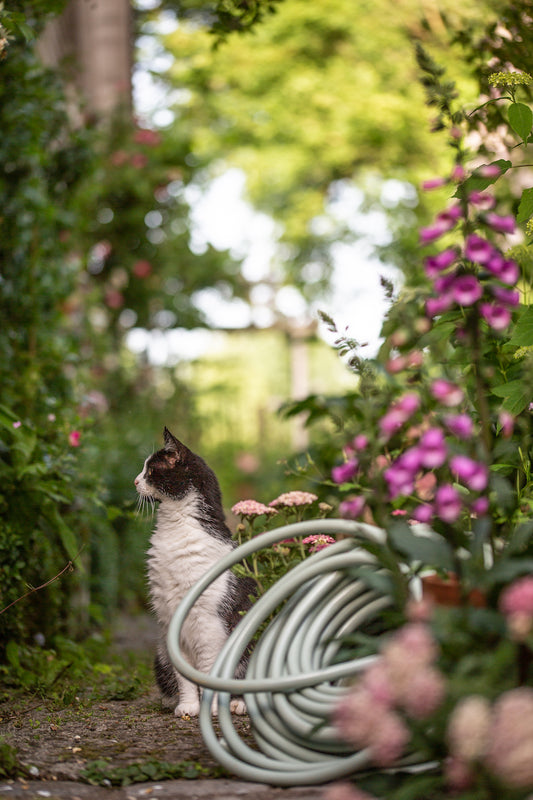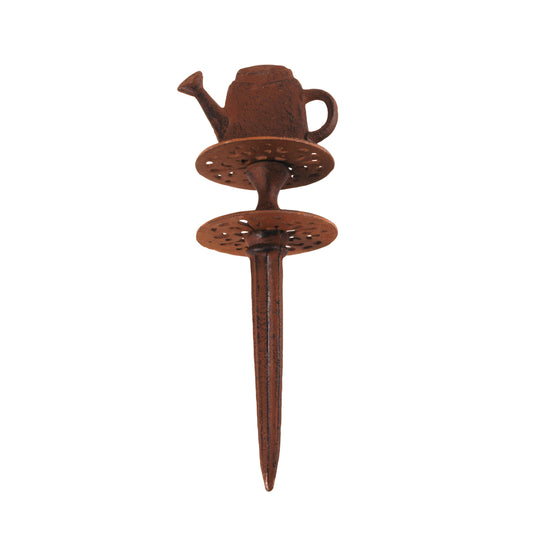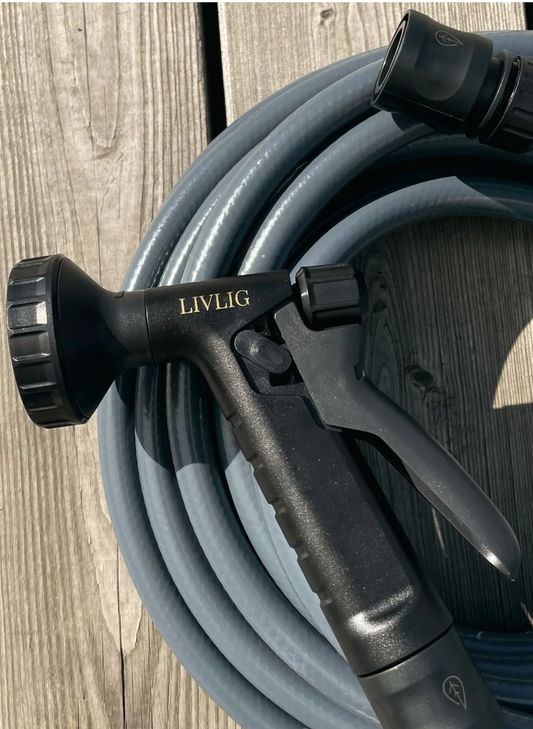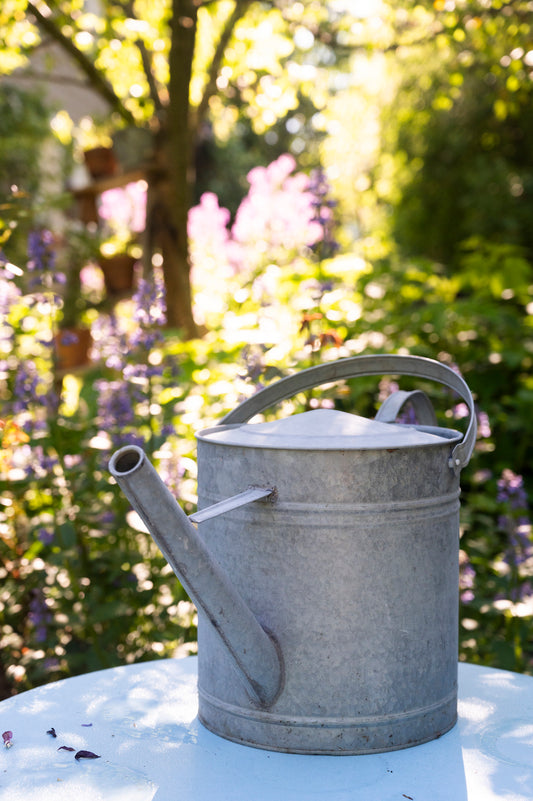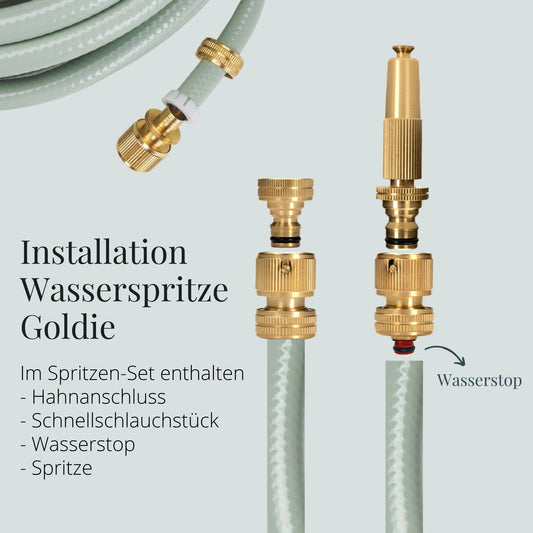WATERING CORRECTLY – A dry topic?
Plenty of sunshine, beach weather, and a picture-perfect summer. As beautiful as that may be, one thing is increasingly lacking in many regions: water. A prolonged, extreme drought is causing serious problems for many farmers and gardeners.

It's been raining here – thank goodness – every now and then. I like to go out on a limb and say that I don't water my garden (except for the pots and freshly planted plants, of course) and that I've trained my plants strictly to let their roots grow well and deep. But what do you do when there's really no rain for weeks, the lawn turns yellow, the trees shed their leaves, and the flowers droop? I spoke with experienced master gardener Barbara Gerlach about what "proper watering" actually means.
Barbara, what's your garden like these days? We haven't had any real rain here for months, and we've had a lot of sun and wind. The plants are suffering. How are you dealing with the drought? I could save myself and my garden a lot of trouble if I simply planted according to the location. That is, choosing plants based on the soil conditions and the hours of sunlight, and planting them in the right spot. But of course, I also want to have a variety of plants in my garden, so I have to water them differently.

Even with this stylish garden hose (which is available in different colors), it is better to water directly at the roots rather than from above.
WHAT DOES THAT LOOK LIKE?
The most important rule is: It's better to water thoroughly once a week rather than just a little every evening. Why is this better? It helps the plants learn to take care of themselves. If I only water a little every evening, I only reach the top layer of soil. The roots then become rotten and stay at the top. But you can train them to grow further down, where they can get their own water. Then I don't have to water as much.
And how much do I need to water if I only do it once a week?
That depends on the plant, specifically the size of the root ball. Because that's what I want to achieve. As a general rule of thumb, you can use the pots you bought a perennial in, for example: The pots are usually about ten centimeters high, which means the water needs to penetrate ten centimeters into the soil – right up to the end of the root ball. With shrubs or trees, of course, it needs to penetrate much deeper. That sounds like a lot of water. And work. Not necessarily. For larger areas, I use a sprinkler with a timer that I can adjust in height and direction. I set it for 90 to 120 minutes – this depends on the soil conditions, of course, so everyone has to experiment – and then the water gets exactly where I want it in sufficient quantities.
If I don't have much experience with this method, how can I know how deep the water has penetrated into the soil?
It's simple: After watering the night before, the next morning I dig deep into the soil with the spade and then pull it slightly toward me. This allows me to see the soil profile and gauge how moist it is. Incidentally, I only use this method for my perennial beds when it's very dry. I usually only water the new perennials with the hose or watering can. But please don't water from above; pour the water directly onto the plant at the very bottom .

AND HOW CAN I ESTIMATE THE RIGHT AMOUNT OF WATER WHEN WATERING WITH A HOSE?
I recommend a little exercise for this: Use the hose – set as you would for watering – to fill a 10-liter watering can and count the seconds. For me, that's about 50 seconds. With the hose, I then need this time to give 10 liters of water to 1 square meter. That would be like 10 ml of rain. In this time, one square meter of area receives the equivalent of about ten milliliters. That's not much; it's just enough for the weeds. That's why I prefer to water specifically with the watering can. I put a watering ring around newly planted trees or shrubs so that the water doesn't just run away above ground, but seeps through the firm root ball into the loose soil. Make sure the watering ring isn't too big, otherwise the water will run directly into the loose soil without reaching the root ball. Depending on the size of the plant, 50 liters of water will fit into the watering ring.
THIS ALSO APPLIES HERE:
It's better to water thoroughly once a week rather than lightly three times. For young trees, this should be 80–100 liters of water per week. Water bags are particularly suitable for this. These are filled once and then slowly release the water into the soil through a membrane.
Is there anything else to consider? Garden hose versus watering can? The right attachment is especially important. The commonly used spray gun doesn't water properly. The fine mist barely reaches the roots; it merely briefly increases the humidity. A hose with a watering device and spray head, a sprinkler, or even a classic watering can are better.
Thank you, Barbara*.

NICE HOSES?
And since hoses are never particularly pretty, I'm happy to have FINALLY found some nice ones. Phthalate-free, in four different colors and two lengths. Made from 60% recycled material, made in Germany, and with a 15-year guarantee. You can find them HERE !

*Barbara Gerlach has been a master gardener since 1982. She lives her credo "so that people and gardens fit together" in her garden consulting.
She would like to convey that the garden is a living space, not a job, and that gardening is more important than gardening.
She grew up in a nursery, spent several years traveling at home and abroad and has been self-employed for over 30 years.
You can find her on her blog " Hortus vivendi ". And if you'd like to know more about her self-employment: " Aus Lust zum Garten "

Photos: Janina Laszlo, Barbara Gerlach

